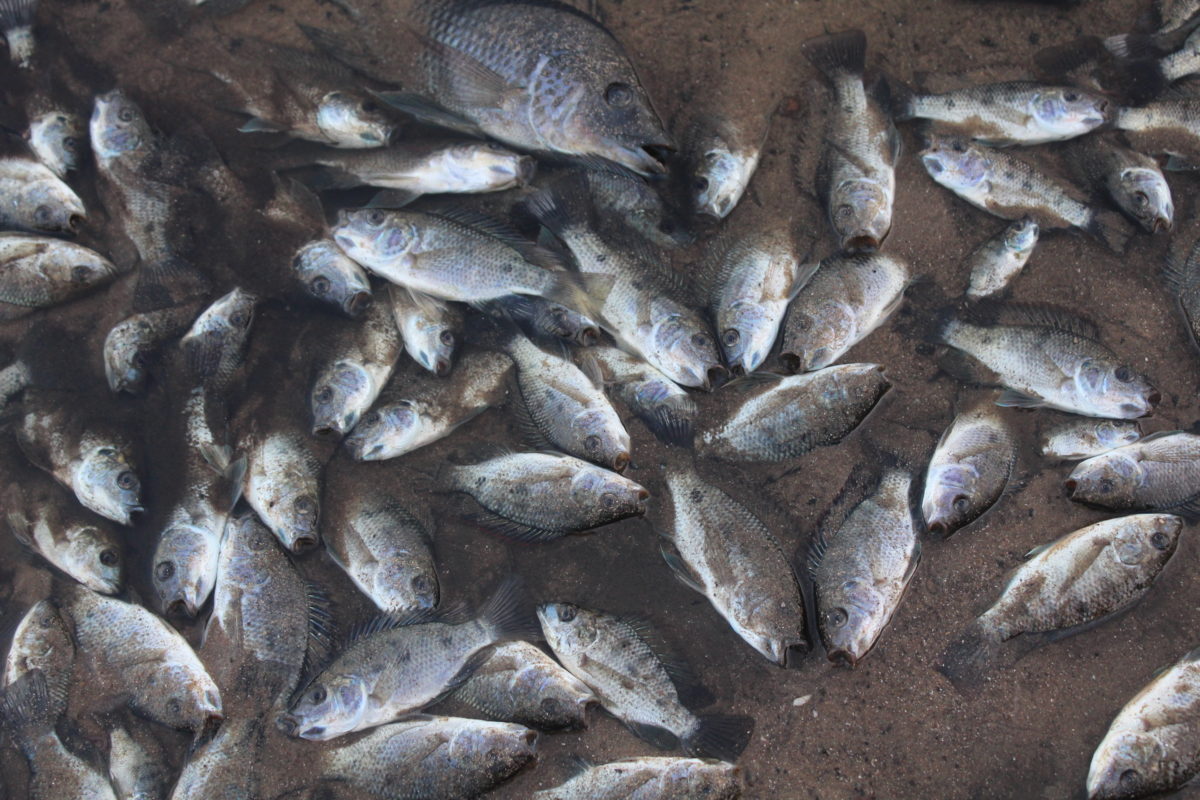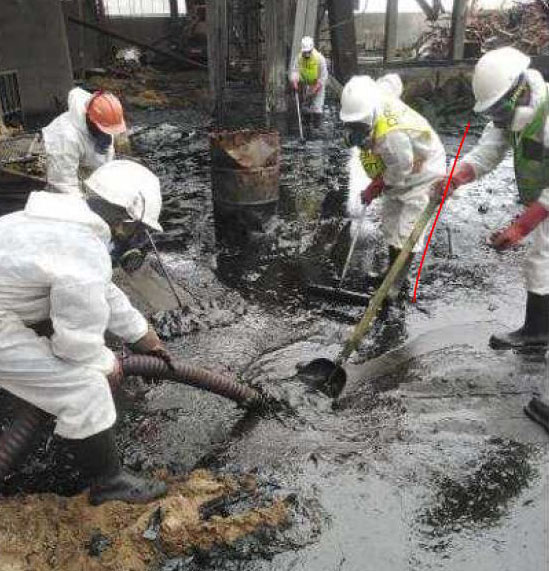- Unknown quantities of toxic agricultural chemicals spilled into an estuary on the Indian Ocean following an arson attack on a warehouse during civil unrest and looting in South Africa in July.
- The fire burned for 10 days, exposing thousands of people to clouds of poisonous fumes and soot, with poor communication of the health risks to affected communities.
- Thousands of fish and other aquatic organisms were killed by a torrent of turquoise effluent that flowed from warehouse, which held as many as 1,600 different types of chemicals.
- The incident has exposed significant weaknesses in the regulation of hazardous installations, along with major flaws in emergency and pollution control response by South African authorities.
In the early hours of July 13, a group of unknown people set fire to a massive warehouse full of agrochemicals in the Cornubia area of Durban on South Africa’s east coast. The fire burned for 10 days, incinerating unknown quantities of hundreds of toxic chemicals in a smoke plume that extended across surrounding residential neighborhoods; firefighting efforts washed bright blue effluent into an adjacent river system, and thousands of riverine and marine creatures washed up dead in the Umhlanga Lagoon and beaches up to 9 kilometers (nearly 6 miles) away.
More than a month later, neither United Phosphorous Limited (UPL), the Indian company leasing the warehouse, nor government officials have released a full inventory of the chemicals — or the total volume involved — but information on the UPL website shows it was marketing hundreds of types of insecticides, pesticides, fungicides, herbicides, rodenticides, surfactants and fumigants, including several compounds that have been linked to death, cancer and birth defects in humans or animals.
Though there are few scientific studies on the impacts of short-term airborne pesticide pollution in South Africa, the potentially devastating impacts of some these substances on pregnant mothers emerged during a study of birth defects at a hospital in Eastern Cape province in 2003, where researchers found that babies born to women exposed to farm chemicals used in gardens and fields were seven times more likely to have birth defects than those whose mothers had no reported exposure.
“These findings suggest a link between exposure to pesticides and certain birth defects among the children of rural South African women who work on the land,” said lead author Gudrun Heeren. “The most commonly used agricultural chemicals and soil additives were insecticides, organophosphates and ‘Blue death,’ the latter a mixture of three different chemicals: carbaryl, carbofuran and camphechlor.”
Carbofurans are among the chemicals marketed on the UPL website, along with glyphosate, a herbicide that has been classified as a probable human cancer-causing agent by the International Agency for Research on Cancer (IARC), the expert body that provides advice to the World Health Organization.
Also listed on UPL’s site are the herbicide 2,4-D, classified by the IARC as possibly carcinogenic to humans; and chlorpyrifos, which has been prioritized for further expert evaluation of its carcinogenic potential.
Senior fire department commander Bruce de Gier confirmed that large volumes of chemicals were incinerated by a massive fireball explosion inside the warehouse, with contaminated water flowing uncontrolled from the site due to the large volume of water used in an attempt to douse the flames.
Video clips and photographs recorded at the height of the fire showed that the Umhlanga Lagoon turned turquoise, while bright blue effluents were seen flowing in a stream a short distance from the UPL warehouse.
The toxic nature of the runoff soon became apparent as thousands of marine and riverine fish species went belly-up in the protected Umhlanga Lagoon Nature Reserve and estuary. Dead crawfish, prawns, crabs and octopus also washed up on beaches near the adjoining uMdloti River estuary.

Dead fish litter the banks of the Umhlanga Lagoon in Durban. In the days following the UPL warehouse fire, some 3.5 tonnes of dead marine life were collected from the Umhlanga estuary. Image by Ben Carnie
In the aftermath of the disaster, UPL and officials are scrambling to answer questions about the apparent absence of safety and pollution control measures and the failure of several regulatory controls.
The fire appears to have been unavoidable, taking place against a wider background of politically inspired arson. It occurred while fire and emergency personnel were battling several other arson fires simultaneously. Yet the first public health warnings about poisonous airborne emissions were only issued five days later, and none of the thousands of residents living in close proximity to the warehouse were evacuated.
Even then, the warnings were muted, with UPL communications spokesman Craig Dodds advising people to remain in their houses if they were in the area of a smoke cloud. “People are also advised to cover their eyes and nose by wearing an ordinary mask and glasses over their eyes.”
The following day, with smoke still pouring over a wide area, UPL revised this advice to suggest that affected people wear two damp surgical masks over their mouths and noses.
The company said very young children and people with asthma should also “avoid being in the immediate surroundings” of the warehouse, while residents with any health concerns were advised to seek medical advice.
At a media briefing while the UPL fire was still burning, municipal air pollution control official Bruce Dale said there was no city-owned monitoring station in the immediate vicinity of the burning warehouse, but highly elevated levels of PM 2.5 fine particulates had been measured at the City Hall monitoring station nearly 17 km (11 mi) away in the immediate aftermath of the explosion.
While this might also be linked to arson attacks in several other parts of the city, further air dispersion modeling analysis was underway.
Desmond D’Sa, coordinator of the South Durban Community Environmental Alliance, said he had received health-related complaints about strong chemical fumes from as far north as Ballito, almost 20 km (12 mi) north of the UPL warehouse, along with numerous complaints from densely populated areas such as Verulam, Tongaat, Phoenix, La Lucia, Umhlanga, Blackburn and Mt. Edgecombe.
“We understand that this was a deliberate arson attack — but we nevertheless believe that the company and the authorities need to be held accountable,” D’Sa said.
“Where are the emergency response plans? Where else in our city are large volumes of hazardous substances being kept in general warehouses that were not designed to control them safely? It is only when there is a disaster, or we receive whistleblower accounts, that we hear about such places,” he said, noting that the existence of another such storage facility came to light near the Durban port.
Shortly after the UPL fire, the Bidvest Group warned that one of its warehouses in Mobeni was also at high risk of releasing up to 500,000 liters (132,000 gallons) of “extremely hazardous chemicals.”
The group said one of its chemical facilities on South Coast Road contained thousands of liters of highly flammable chemicals, but the warehouse sprinkler system and other control systems had been damaged by looters.
But within the broader natural environment, fish and other aquatic creatures had nowhere to hide from their poisoned living spaces.
Several local estuarine experts have declined to comment on the record until more information becomes available about the exact volumes and toxicity of chemicals that entered the estuary and marine environment — though one senior scientist familiar with the Umhlanga estuary has suggested that all aquatic life appears to have been “exterminated” and that serious risks remain for future fish recruitment from the ocean as vegetation and muddy sediments in the estuary were polluted with highly toxic or persistent pollutants.
Though the Umhlanga Lagoon Nature Reserve is a relatively small reserve (26 hectares, or 64 acres) in a densely populated city, it still serves as an important nursery area for marine fish and is a haven for more than 200 bird species.
These include fish eagles, herons, African rails, the elusive Narina trogon and tinker barbets, along with small mammals such as bushbucks and blue and gray duikers. The reserve adjoins the privately protected Hawaan Forest.
David Allan, curator of birds at the Durban Natural Science Museum, said that while the long-term impacts of the UPL chemical spill were still uncertain, he was concerned that several raptors and fish-eating species could be at risk of poisoning unless dead fish in the estuary were removed consistently.
“Fish eagles, yellow-billed kites, terns, gulls and kingfishers are most at risk from scavenging dead or dying fish,” he said.
The big worry, Allan said, was around how long the poisons would remain in the muddy substrates and whether they would break down naturally or need to be removed manually to prevent them accumulating within the food chain.
What has become clear, however, is that the 14,000-square-meter (151,000-square-foot) warehouse was not designed specifically to store poisonous chemicals. Nor does there appear to have been an environmental impact assessment (EIA) to assess site-specific pollution risks in the case of a major disaster, fire or accident at a major chemical storage facility.
The provincial department of environmental affairs has released a copy of a 252-page integrated EIA which it approved in 2015 for a project known as the Greater Cornubia mixed-use development project.
Developed jointly by the city of Durban and the Tongaat Hulett group, the greater development scheme involved new roads, bridges and other infrastructure for more than 25,000 new residential homes, shopping centers, and a smaller light industrial area (which the developers envisaged would be “clean and green”).
Buried within this environmental authorization is a clause that states: “Private facilities that require the storage and handling of dangerous goods that exceed 80m3 [21,100 gallons] in capacity are subject to a separate EIA application prior to the construction and installation of such infrastructure.”
After this integrated approval, several smaller parcels of land were sold to private developers, including Capital Propfund (Pty.) Ltd. and Lussindale Investments Proprietary Limited.
The warehouse was then built and marketed by the Fortress Real Estate Investments group. Fortress legal counsel Dov Green has not responded to written queries on whether the leased warehouse was purpose-built to house dangerous chemicals or whether a full EIA was done.

UPL’s 14,000-square-meter warehouse was not designed specifically to store poisonous chemicals. No assessment of risks in the case of a major disaster at the facility appears to have been done. Image by Tony Carnie.
Dale, the senior municipal air pollution control official, told Mongabay there is no record of a major hazard installation application from UPL, or a scheduled trade permit, as required by city bylaws. Nor did UPL apply for a certificate of registration for the storage of flammable liquids, the city has confirmed.
Further questions remain unresolved about the apparent failure to install impermeable bunds around the UPL warehouse to contain a major spillage of chemicals into the environment. Bunds are concrete ditches, similar to empty castle moats, designed to capture toxic and flammable substances that leak from ruptured storage tanks.
All the same, as the many unanswered questions and concerns keep piling up in the wake of the Cornubia chemical disaster, civil society groups are pressing for greater accountability from storage companies, landowners, regulators and other responsible parties.
Citation
Heeren, G. A., Tyler, J., & Mandeya, A. (2003). Agricultural chemical exposures and birth defects in the Eastern Cape province, South Africa a case – control study. Environmental Health, 2(1). doi:10.1186/1476-069x-2-11
Tony Carnie is a KwaZulu-Natal based freelance journalist.
https://news.mongabay.com/2021/08/natur ... 6184f5e008















